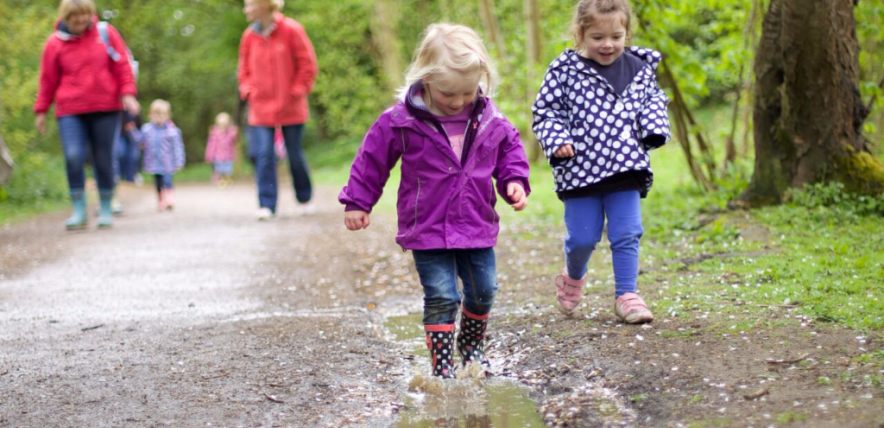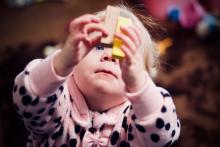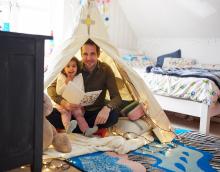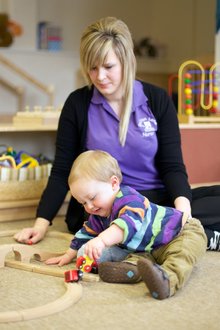For young children, a walk in the woods can be an exiting journey into science or art, as well as great exercise for their bodies and imaginations. The next time you head out for a traipse among the trees try some of our woodland activities with your little one.
Many children's lives today are full of screen-time, car journeys and adult-led indoor activities – leading to worries about the possibility of 'nature-deficit disorder'. Richard Louv, the author and journalist who coined the phrase, explains: “Kids who don't get nature-time seem more prone to anxiety, depression and attention-deficit problems.”
Over the years since Louv's book Last Child in the Woods was published, we've seen an increasing appreciation of the benefits of woodland education in the UK. Organisations such as the Woodland Trust, Forestry Commission and National Trust offer fantastic resources and activities to encourage children to connect with nature, and a growing number of pre-schools and schools are laying on forest school sessions for pupils.
Advocates of woodland learning say it improves children's concentration, motivation and confidence by giving them the space, time and freedom to guide their own education. It's also great for developing language, physical and scientific skills, and can be particularly beneficial for children who struggle in formal classroom settings. So why not give it a try?
Tree-mendous!
Trees offer endless opportunities for learning. Talk to your child about the difference between evergreen and deciduous trees. Can they find an example of each? Chat about things at home that are made from different kinds of trees – a pine bed or oak table for instance. How many more wooden things can they think of? Did they know that wood is used for making paper? Or that cork, rubber and maple syrup also come from trees?
In the autumn, look at the way different trees protect and spread their seeds. Can they find sweet chestnuts in a spiky case, a prickly beech-nut case with a velvety-soft inside, an acorn in its hard cup, or a spiny horse chestnut case containing a shiny conker? Pine-cones open up to spread their seeds when it's warm and dry, and close to protect them when it's cold or wet. If you find some, take them home to experiment with. Sycamore, ash and maple trees produce winged seeds, or samaras. Toss them into the air and watch them twirl to the ground, and you'll see why many people call them spinning jennies or helicopters.
If you find a fallen tree, have a look at the roots and discuss how, as well as keeping the tree stable and straight, they also draw up water and nutrients from the ground. Does their shape remind your child of anything? A freshly sawn tree-stump provides an opportunity for counting rings in the wood to find how old a tree is. And of course stumps and fallen trees are always great fun to climb on!
Nature's paintbox
While you're in the woods, have a go at some forest art. Take crayons and paper for bark-rubbing, or find a selection of leaves for making leaf-rubbings and leaf prints. Talk about the different shapes of leaves & the pattern of veins inside them. Can you work out which trees they're from?
When the beautiful autumn colours arrive, give your child a cardboard headband with a strip of double-sided sticky tape around the outside and encourage them to choose and stick their favourite fallen leaves to make a stunning autumnal crown.
Leaves, moss, bark, sticks, pine-cones and rocks are perfect materials for a large-scale outdoor artwork. How about a hedgehog, butterfly or abstract design? (Type 'forest school art' into Google or Pinterest for hundreds of ideas.) Alternatively, make arrows and other symbols to mark out a woodland trail, or use thread to tie woodland 'treasure' such as skeleton leaves, seed pods, feathers and fir cones onto sticks to make a natural mobile.
Imaginations run wild
A woodland is a perfect setting for imaginative play. Don't be surprised if your child points out a fairy's home, picks up a magic wand, or climbs onto a witch's broomstick. Try searching for a fairy-ring of mushrooms together, making a tiny shelter or garden for forest-dwellers, or laying out miniature meals by placing seeds and berries on leaf plates.
Other children's imaginative play might involve using sticks as magic wands, or fallen branches to build a den or human-sized nest. If your little one becomes absorbed in imaginative- or role-play, try not to guide them or set limitations (unless their safety is at risk) and only offer help if they ask for it.
Explore more
A trip to the woods tends to bring out children's adventurous side, so put them in old clothes and sturdy boots and let them climb trees and jump in muddy puddles. As your little explorer becomes more intrepid, seek out new woodland activities – how about geocaching, dam-building, campfire cooking, a night hike or a camping trip? Children's bushcraft and forest school sessions are becoming increasingly popular, so find out what's going on in your area.
NB: Remember some plants and seeds can be harmful, so always supervise your child when exploring the outdoors.
Further information:
www.woodlandtrust.org.uk/naturedetectives/
www.nationaltrust.org.uk/50-things-to-do
www.forestschoolassociation.org/what-is-forest-school/
Written for the Early Years Alliance by Elyssa Campbell-Barr.







